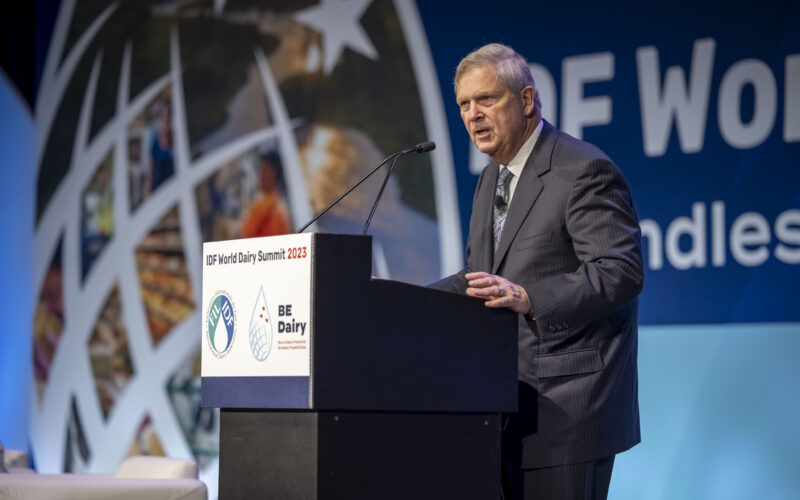The wellbeing of his country’s dairy industry is front of mind for United States Secretary of Agriculture Tom Vilsack as its farmers battle the impact of climate change and farm consolidation.
A staggering 92.5% of dairy farmers collectively share only 11% of the total income derived from dairy operations in the US, underscoring the immediate need for attention and support.
Speaking at the International Dairy Federation’s 2023 World Dairy Summit in Chicago, Vilsack shed light on the proactive measures the US is undertaking to safeguard the long-term sustainability of agriculture.
“Farmers have told us they want a voluntary system that is incentive-based and understands and encourages the market to recognise the contribution they’re making.
“They want to make sure that there is a strong and valid method of recording, measuring, and monitoring as well as verifying results so we can assure consumers that the items they’re purchasing have been sustainably produced.
“And they want it to be a collaborative partnership, so we have established the climate-smart partnership initiative.”
Under the Partnerships for Climate-Smart Commodities, the US Department of Agriculture announced it would finance partnerships to support the production and marketing of climate-smart commodities via a set of pilot projects lasting one to five years.
In the first pool, 70 projects were selected to receive an investment of up to US$2.8 billion (about $4.75bn), which increased by another 71 projects and a further US325 million investment at the end of 2022.
The projects that will receive funding include precision agriculture, biofuels, marketing and education programmes.
“We recognise the opportunity to create a value-add commodity so that farmers not only are paid to do the climate-smart practices that we think will be beneficial to the climate, but they’re also rewarded in the marketplace with a value-add proposition.”
He said he believes consumers in the US are interested in and willing to invest in sustainably produced products, but they need proof that these products are what they say. He knows the deep care dairy farmers have for their operations, the environment, and their communities.
“I think it’s up to us in the policy-making arena to ensure that we’re taking the appropriate steps to create a programme that understands and appreciates all types of farmers.
“That’s why I’m excited about this opportunity to create an entrepreneurial model that complements our production agriculture model. We’re going to continue to need strong production from American agriculture to feed the world and we’re also going to need to make sure we create that opportunity for small to midsize business so we retain the vibrancy of our rural communities.”
Vilsack does not like it that 57 million hectares of land in the US is no longer used for farming. That land mass equates to the entire states of Florida, Georgia, North Carolina and South Carolina combined, which is a tremendous loss.
Vilsack spent four years in the US Dairy Export Council before returning to the USDA. He said he is keen to protect US agriculture by supporting sustainability and achieving fair market value.
“My four years in the dairy industry allowed me to learn of the potential. It was the dairy industry first and foremost that saw the capacity and opportunity to essentially get to a net zero future.
“It was the dairy industry in the United States that encouraged a voluntary and market-based system that would listen to farmers and reward farmers for addressing the climate.
“I’ll be forever grateful to the industry for doing that and I think this industry can take pride in the fact that you’ve already started that effort, to tap the boundless potential and endless possibility of not just the dairy sector but of all agriculture.”
Find out more about the USDA Partnerships for Climate-Smart Commodities here.
This article first appeared in the December edition of our sister publication, Dairy Farmer. Samantha Tennent attended the event with support from WelFarm and the International Dairy Federation.






